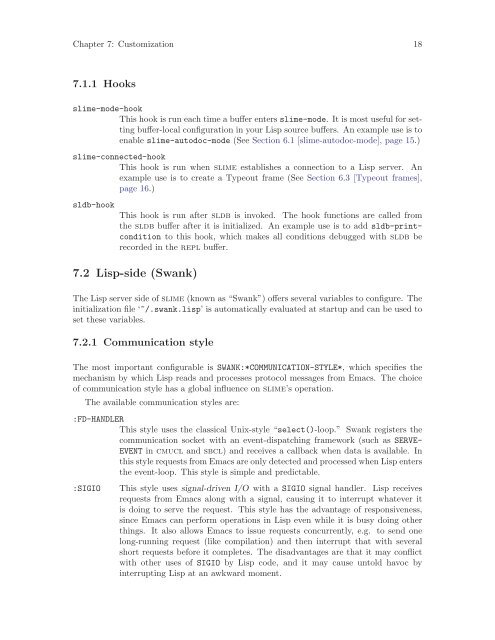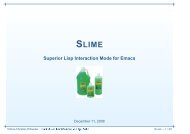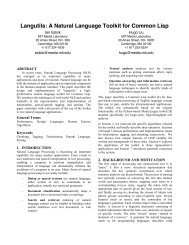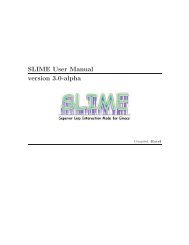SLIME User Manual - Common Lisp.net
SLIME User Manual - Common Lisp.net
SLIME User Manual - Common Lisp.net
- No tags were found...
Create successful ePaper yourself
Turn your PDF publications into a flip-book with our unique Google optimized e-Paper software.
Chapter 7: Customization 187.1.1 Hooksslime-mode-hookThis hook is run each time a buffer enters slime-mode. It is most useful for settingbuffer-local configuration in your <strong>Lisp</strong> source buffers. An example use is toenable slime-autodoc-mode (See Section 6.1 [slime-autodoc-mode], page 15.)slime-connected-hookThis hook is run when slime establishes a connection to a <strong>Lisp</strong> server. Anexample use is to create a Typeout frame (See Section 6.3 [Typeout frames],page 16.)sldb-hookThis hook is run after sldb is invoked. The hook functions are called fromthe sldb buffer after it is initialized. An example use is to add sldb-printconditionto this hook, which makes all conditions debugged with sldb berecorded in the repl buffer.7.2 <strong>Lisp</strong>-side (Swank)The <strong>Lisp</strong> server side of slime (known as “Swank”) offers several variables to configure. Theinitialization file ‘~/.swank.lisp’ is automatically evaluated at startup and can be used toset these variables.7.2.1 Communication styleThe most important configurable is SWANK:*COMMUNICATION-STYLE*, which specifies themechanism by which <strong>Lisp</strong> reads and processes protocol messages from Emacs. The choiceof communication style has a global influence on slime’s operation.The available communication styles are::FD-HANDLERThis style uses the classical Unix-style “select()-loop.” Swank registers thecommunication socket with an event-dispatching framework (such as SERVE-EVENT in cmucl and sbcl) and receives a callback when data is available. Inthis style requests from Emacs are only detected and processed when <strong>Lisp</strong> entersthe event-loop. This style is simple and predictable.:SIGIOThis style uses signal-driven I/O with a SIGIO signal handler. <strong>Lisp</strong> receivesrequests from Emacs along with a signal, causing it to interrupt whatever itis doing to serve the request. This style has the advantage of responsiveness,since Emacs can perform operations in <strong>Lisp</strong> even while it is busy doing otherthings. It also allows Emacs to issue requests concurrently, e.g. to send onelong-running request (like compilation) and then interrupt that with severalshort requests before it completes. The disadvantages are that it may conflictwith other uses of SIGIO by <strong>Lisp</strong> code, and it may cause untold havoc byinterrupting <strong>Lisp</strong> at an awkward moment.















